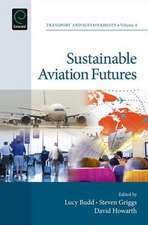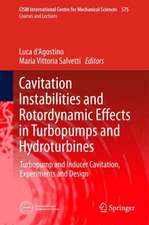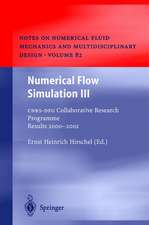Aeronautical Research in Germany: From Lilienthal until Today
Autor Ernst Heinrich Hirschel, Horst Prem, Gero Madelungen Limba Engleză Paperback – 9 noi 2012
Featuring hundreds of historic photos and non-technical language, this comprehensive and scholarly account will interest historians, engineers, and, also, all serious airplane devotees. Through individual contributions by 35 aeronautical experts, it covers in fascinating detail the milestones of the first 100 years of aeronautical research in Germany, within the broader context of the scientific, political, and industrial milieus. This richly illustrated and authoritative volume constitutes a most timely and substantial overview of the crucial contributions to the foundation and advancement of aeronautics made by German scientists and engineers.
| Toate formatele și edițiile | Preț | Express |
|---|---|---|
| Paperback (1) | 842.79 lei 38-44 zile | |
| Springer Berlin, Heidelberg – 9 noi 2012 | 842.79 lei 38-44 zile | |
| Hardback (1) | 1489.14 lei 6-8 săpt. | |
| Springer Berlin, Heidelberg – 2 dec 2003 | 1489.14 lei 6-8 săpt. |
Preț: 842.79 lei
Preț vechi: 1108.94 lei
-24% Nou
Puncte Express: 1264
Preț estimativ în valută:
161.26€ • 168.83$ • 133.44£
161.26€ • 168.83$ • 133.44£
Carte tipărită la comandă
Livrare economică 01-07 aprilie
Preluare comenzi: 021 569.72.76
Specificații
ISBN-13: 9783642621291
ISBN-10: 3642621295
Pagini: 736
Ilustrații: XXII, 694 p.
Dimensiuni: 193 x 242 x 39 mm
Greutate: 1.41 kg
Ediția:Softcover reprint of the original 1st ed. 2004
Editura: Springer Berlin, Heidelberg
Colecția Springer
Locul publicării:Berlin, Heidelberg, Germany
ISBN-10: 3642621295
Pagini: 736
Ilustrații: XXII, 694 p.
Dimensiuni: 193 x 242 x 39 mm
Greutate: 1.41 kg
Ediția:Softcover reprint of the original 1st ed. 2004
Editura: Springer Berlin, Heidelberg
Colecția Springer
Locul publicării:Berlin, Heidelberg, Germany
Public țintă
Popular/generalDescriere
From the pioneering glider flights of Otto Lilienthal (1891) to the advanced avionics of today’s Airbus passenger jets, aeronautical research in Germany has been at the forefront of the birth and advancement of aeronautics. On the occasion of the centennial commemoration of the Wright Brother’s first powered flight (December 1903), this English-language edition of Aeronautical Research in Germany recounts and celebrates the considerable contributions made in Germany to the invention and ongoing development of aircraft.
Featuring hundreds of historic photos and non-technical language, this comprehensive and scholarly account will interest historians, engineers, and, also, all serious airplane devotees. Through individual contributions by 35 aeronautical experts, it covers in fascinating detail the milestones of the first 100 years of aeronautical research in Germany, within the broader context of the scientific, political, and industrial milieus. This richly illustrated and authoritative volume constitutes a most timely and substantial overview of the crucial contributions to the foundation and advancement of aeronautics made by German scientists and engineers.
Featuring hundreds of historic photos and non-technical language, this comprehensive and scholarly account will interest historians, engineers, and, also, all serious airplane devotees. Through individual contributions by 35 aeronautical experts, it covers in fascinating detail the milestones of the first 100 years of aeronautical research in Germany, within the broader context of the scientific, political, and industrial milieus. This richly illustrated and authoritative volume constitutes a most timely and substantial overview of the crucial contributions to the foundation and advancement of aeronautics made by German scientists and engineers.
Cuprins
Part 1 Introduction.- Aeronautical Research and Technology.- Part 2 The Political, Institutional and Industrial Environment of German Aeronautical Research.- Aeronautical Research Comes into Being During the Time of the Empire.- The Difficult Situation of Aeronautical Research and the Aeronautical Industry During the Weimar Republic, 1919–1932.- The High Rating of Aeronautical Research During the Third Reich.- The Reconstruction of German Aeronautical Research after 1945.- Part 3 Results of German Aeronautical Research.- From the Beginning to the End of World War Two.- Concept and Configuration.- Aerodynamics – the Key to Successful Flight.- Aeroengines – Performance and Speed Increase as Impetus for Development.- Flight Mechanical Stability and Control.- Lightweight Construction – a Prerequisite for Flight.- Aeroelasticity – The Interaction of the Elastic Aircraft Structure with Aerodynamic Forces.- First Helicopters and Rotor Systems.- Rescue and Safety.- Transfer of German Aeronautical Knowledge After 1945.- Research Results of the Period After 1945.- A New Beginning.- Aerodynamics – from Near-Sonic to Hypersonic Flight.- Propulsion Technology – Economic and Ecological Challenge.- Flying Qualities, Instable Flight, Avionics, Cockpit, Sensorics.- Ultra-Lightweight Construction – From Metal to Fibre Structures.- Aeroelasticity – New Challenges and Problems.- Advances in Helicopter Rotor Technology.- Large-scale Facilities to Test Safety, Reliability and Environmental Compatibility.- Safety, Reliability and Environmental Compatibility within the Global Air, Transport System.- Ground Test Facilities.- In-Flight Simulation in Germany.- Part 4 International and Economical Relevance and Perspectives.- The Significance of Aeronautical Research in Germany – Nationally and Internationally.- Conclusions and Perspectives.
Textul de pe ultima copertă
From the pioneering glider flights of Otto Lilienthal (1891) to the advanced avionics of today’s Airbus, aeronautical research in Germany has been at the forefront of the birth and advancement of aeronautics. On the occasion of the centennial commemoration of the Wright Brother’s first powered flight (December 1903), this English–language edition of ‘Aeronautical Research in Germany’ recounts and celebrates the considerable contributions made in Germany to the invention and ongoing development of aircraft.
Featuring hundreds of historic photos and non-technical language, this comprehensive and scholarly account will interest historians, engineers, and, also, all serious airplane devotees. Through individual contributions by 35 aeronautical experts, it covers in fascinating detail the milestones of the first 100 years of aeronautical research in Germany, within the broader context of the scientific, political, and industrial milieus.
Important contributions of German aeronautical research to the flight sciences are, for example, the boundary-layer theory (1904), the lifting-wing theory (1918), the Wagner Web (1924), the boundary-layer stability theory (1929), the swept wing (1935) and its experimental verification (1939), the axial compressor (minimum frontal area) for jet engines (2nd half of the thirties), the transonic airfoil (1940), the area rule (1943), and the first application of a supercritical wing (Airbus A310, 1982).
The technological developments led in Germany to breakthroughs in aircraft design, including the modern high-speed aircraft (He 70, 1932), the first operational helicopter (Fw 61, 1936), rocket plane (He 176, 1939), jet plane (He 178, 1939), the Me 163 (1941), the Me 262 (1941/1942), the ejector seat (1942), the first quantity production jet engines Jumo 004 (1943) and BMW 003 (1944), the variable swept wing jet (Me P 1101, 1945), V/STOL aircraft (VJ 101 C, 1963), and controlled post-stall flight (X-31, 1990).
This richly illustrated and authoritative volume constitutes a most timely and substantial overview of the crucial contributions to the foundations and advancement of aeronautics made by German scientists and engineers.
Featuring hundreds of historic photos and non-technical language, this comprehensive and scholarly account will interest historians, engineers, and, also, all serious airplane devotees. Through individual contributions by 35 aeronautical experts, it covers in fascinating detail the milestones of the first 100 years of aeronautical research in Germany, within the broader context of the scientific, political, and industrial milieus.
Important contributions of German aeronautical research to the flight sciences are, for example, the boundary-layer theory (1904), the lifting-wing theory (1918), the Wagner Web (1924), the boundary-layer stability theory (1929), the swept wing (1935) and its experimental verification (1939), the axial compressor (minimum frontal area) for jet engines (2nd half of the thirties), the transonic airfoil (1940), the area rule (1943), and the first application of a supercritical wing (Airbus A310, 1982).
The technological developments led in Germany to breakthroughs in aircraft design, including the modern high-speed aircraft (He 70, 1932), the first operational helicopter (Fw 61, 1936), rocket plane (He 176, 1939), jet plane (He 178, 1939), the Me 163 (1941), the Me 262 (1941/1942), the ejector seat (1942), the first quantity production jet engines Jumo 004 (1943) and BMW 003 (1944), the variable swept wing jet (Me P 1101, 1945), V/STOL aircraft (VJ 101 C, 1963), and controlled post-stall flight (X-31, 1990).
This richly illustrated and authoritative volume constitutes a most timely and substantial overview of the crucial contributions to the foundations and advancement of aeronautics made by German scientists and engineers.
Caracteristici
A must for every airplane lover
Popular book written by german aeronautics experts
Covers in detail the fascinating last 100 years of german aerospace research and its important impacts to aviation history
Examples are Berblinger, (the famous Taylor of Ulm), Otto Lilienthal, Graf Zeppelin, Junkers, Messerschmitt, or Bölkow
Organized by EADS with a forword by Ludwig Bölkow
Popular book written by german aeronautics experts
Covers in detail the fascinating last 100 years of german aerospace research and its important impacts to aviation history
Examples are Berblinger, (the famous Taylor of Ulm), Otto Lilienthal, Graf Zeppelin, Junkers, Messerschmitt, or Bölkow
Organized by EADS with a forword by Ludwig Bölkow



















